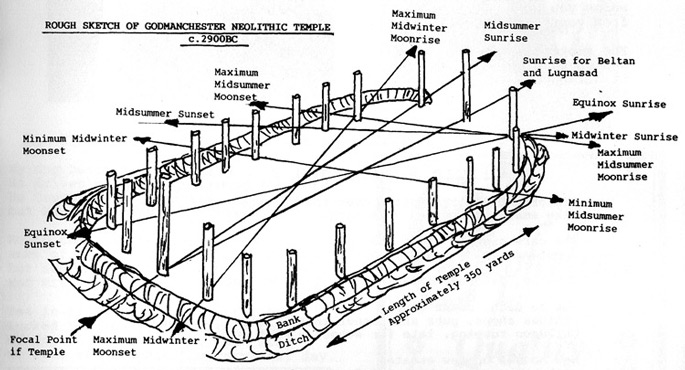It is difficult to imagine what was happening around and about Cow Lane 5000 years ago. Farming was 2000 years old in Britain at the time, but the wheel and the plough, only invented 500 years earlier had probably not reached the area.

While somewhere in Sumeria writing had just been invented and in Egypt the first pyramids were being built, in Godmanchester someone was building a temple. Its design was not based upon architectural ideas but on the positions of the rising and setting of the sun and moon during the course of the year.
The Neolithic people, having dug more than half a mile of banks and ditches as the foundations, cut trees in obelisks (some up to twenty feet high) and throughout the year positioned them appropriately. Twenty-four such poles were used, sunk four feet into the ground. The choice of position included where the sun rose and set at mid-summer day and where the moon rose and set on the same day. Similar positions were chosen for the mid-winter, spring and autumn equinoxes - that is to say when the sun appears vertically overhead at noon.
Additional positions included the mid-points between these and represented important festivals . The mid-point of the spring equinox and mid-summer was the festival to the sungod Belinus, Beltane and celebrated the re-birth of summer. The mid-point between midsummer and the autumn equinox was the festival to the god Lug or Lugus called Lugnusad and celebrated the harvest. Lug was one of the most important, powerful and impressive of the Celtic deities and as well as many stories being told about him, many places have been named after him. Lyon in France, Leiden in Holland, and Carlisle (which the Romans called Luguvalium "Strong in the God Lugus" are a few).
Many prehistoric monuments have astronomical alignments so this in itself is not unusual but the site at Godmanchester is, astronomically, by far the most elaborate found in Western Europe - Far more so than Stonehenge which it pre-dates by about 800 years and which, in size, covers an area thirty times greater.
The site has been excavated by English Heritage who expect to publish a full report on their findings in 1993. Meanwhile much has already been discovered. Nearly all of a dismembered human skeleton has been uncovered which suggests that human sacrificial rites may have been performed there. Each of the totem poles has been individually and deliberately burnt to the ground apparently with such ferocity that even the bases were partially consumed in the heat.
The excavations suggest that the site was only in use for a few decades before being destroyed but within a few months a second temple was constructed with a different design and purpose. Whereas the original measured approximately three hundred and fifty yards in length and one hundred and ninety yards wide, the new building was exactly half the width and probably much longer. Current estimates suggest anything from a quarter of a mile to an amazing three miles in length. This site was probably used for funerals.
More than 1000 years ago, in what had been the south-west corner, later tribesmen from the Bronze Age constructed what may have been a small temple, complete with wells. Even as late as Roman times, 3000 years later, the site may have been regarded as sacred ground because an agricultural factory, with a granary, vast processing barns for grain and, of course, baths, have been found bordering the site but not on it. Even up to that time, throughout the Bronze and Iron Ages, no evidence has been found to suggest that the area was at all farmed although field systems are to be found close by.